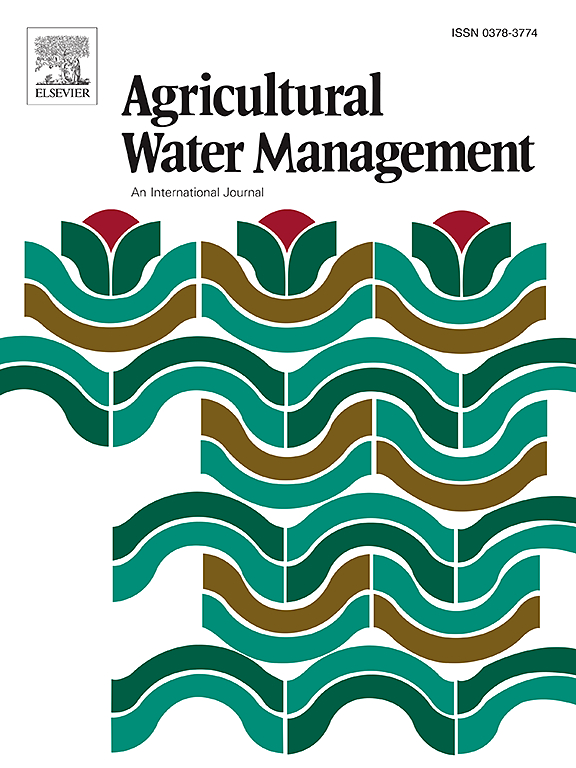Irrigation and nitrogen fertilizer increase wheat productivity by improving root-shoot population coordination
IF 5.9
1区 农林科学
Q1 AGRONOMY
引用次数: 0
Abstract
The optimization of plant root distribution plays an important role in obtaining deep soil resources, and enhancement of photosynthetic performance has been demonstrated to maintain wheat production, but the ideal water-nitrogen (N) utilization regime for winter wheat root-shoot growth remains unclear. A 2-year field experiment was conducted during the wheat growing seasons of 2020–2022, with two irrigation levels (W0, no irrigation; W1, irrigation 75 mm at jointing and anthesis stages) and three N rates (N0, 0 kg ha−1; N180, 180 kg ha−1; N300, 300 kg ha−1), N was applied before ploughing (50 %) and jointing stage (50 %). Wheat yield and yield components, leaf area index (LAI), radiative vegetation index, population canopy apparent photosynthesis (CAP), and root system architecture were examined. Irrigation significantly increased the spike number by 13.5 %, and the yield by 15.5 % (P < 0.05) with respect to W0. N fertilization increased the spike number and grains per spike by 34.3 % and 11.2 % with respect to N0. Population quality (LAI, vegetation index, and ratio vegetation index) also increased under irrigation and N treatments; W1N180 increased the canopy photosynthetic rate by 3.5 %–12.8 % with respect to W1N300. Structural equation modeling indicated that root dry weight density (RWD) had a direct positive effect on CAP, whereas CAP and root-shoot ratio had significant effects on yield, and the physiological efficiency of N had direct negative effects on changes in grain yield. Therefore, W1N180 treatment may be considered the optimal management practice for resource use efficiency and environmental benefits of sustainable agricultural development.
灌溉和氮肥通过改善根冠群体协调来提高小麦产量
优化植物根系分布对获取深层土壤资源具有重要作用,提高光合性能对维持小麦产量具有重要作用,但冬小麦根冠生长的理想水氮利用机制尚不清楚。在2020-2022年小麦生长季进行了为期2年的田间试验,采用2个灌溉水平(W0,不灌溉;W1,拔节和开花期灌水量为75 mm)和3种施氮量(N 0,0 kg ha−1;180年N180 公斤 公顷−1;氮肥300,300 kg ha−1),耕前施氮肥(50 %)和拔节期施氮肥(50 %)。研究了小麦产量及产量构成、叶面积指数、辐射植被指数、种群冠层表观光合作用(CAP)和根系构型。与W0相比,灌水显著提高穗数13.5 %,产量15.5 % (P <; 0.05)。施氮使穗数和穗粒数比施氮增加34.3% %和11. %。灌水和施氮处理下,种群质量(LAI、植被指数和比值植被指数)均有所提高;与W1N300相比,W1N180使冠层光合速率提高了3.5 % ~ 12.8 %。结构方程模型表明,根干重密度(RWD)对CAP有直接的正影响,而CAP和根冠比对产量有显著的影响,氮的生理效率对产量的变化有直接的负影响。因此,W1N180处理可被认为是农业可持续发展资源利用效率和环境效益的最佳管理实践。
本文章由计算机程序翻译,如有差异,请以英文原文为准。
求助全文
约1分钟内获得全文
求助全文
来源期刊

Agricultural Water Management
农林科学-农艺学
CiteScore
12.10
自引率
14.90%
发文量
648
审稿时长
4.9 months
期刊介绍:
Agricultural Water Management publishes papers of international significance relating to the science, economics, and policy of agricultural water management. In all cases, manuscripts must address implications and provide insight regarding agricultural water management.
 求助内容:
求助内容: 应助结果提醒方式:
应助结果提醒方式:


